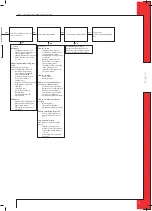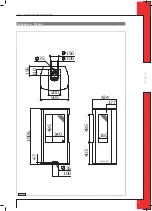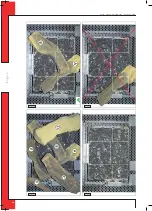
English
T R I O
-
I N S T R U C T I O N
F O R
I N S TA L L AT I O N
7.1.1 Placing / replacing the batteries
Follow the procedure below when placing the batteries:
➠
Open the door of the stove.
➠
Pick up the receiver.
➠
Slide the cover off.
➠
Place or remove the 4 penlite (AA type) batteries.
!Caution
-
Avoid a short circuit between the batteries and metal objects/parts;
-
Observe the “+” and “-” poles of the batteries and the holder;
-
Use alkaline batteries.
➠
Slide back the cover.
➠
Place back the receiver.
!Caution
Batteries are regarded as “small chemical waste” and may therefore not be disposed with the household rubbish.
7.2 Setting the communication code
Prior to putting the application into operation, a communication code must be set between the remote control
and the receiver. If the receiver or the remote control are replaced, a new code will have to be set.
Follow the procedure described below:
➠
If necessary, place the batteries in the receiver’s battery holder; see section 6.1.1.
➠
If necessary, place the 9V block battery in the remote controle; see User Manual.
➠
Hold down the reset button on the receiver, until you hear two consecutive sound
signals (
see Appendix 4, Fig. 24
).
➠
After the second, longer signal, let go of the reset button.
➠
Press the ‘small flame’ button on the remote control for 20 seconds, until you hear two short sound signals: this is the
confirmation of a good communication.
7.3 Alternative operation
Appliances made with an electronic ignition and radio remote control can be connected to an alternative external
control system (e.g. Domotics). For this purpose, there are 4 connection points at the side of the receiver (
see Ap-
pendix 4, Fig. 20
). For connecting an external control unit, you will need a “Domotics connection cable for GV60”.
Consult DRU’s service website.
The following contacts are possible:
- Ignition: connect both contacts 1 + 3, for one second (if there is a 2nd thermocouple, the appliance should burn
at full power for at least 20 sec. before the required position can be chosen).
- Flame high(er): briefly close contact 1 once per step, or 12 seconds for the highest position.
- Flame low(er) until switch-off (pilot flame remains on): briefly close contact 3 once per step, or 12 seconds for the
lowest position.
- Completely switching off the appliance (pilot flame included): close all three contacts 1 + 2 + 3, for one second.
The appliance will always continue to respond to the radio remote control supplied with it. The external control
system is able to use one of the two modes of this remote control.
1. Manual mode
This mode of the remote control is passive and will not take any action unless it is operated. The external control
system is able to control the functions for high/low position, ignition and switching off.
!Tip
If the external control system has an intelligent clock function and/or thermostat function, the remote control sup-
plied with the appliance should have the manual mode in order to prevent interruption of these functions.
2. Clock/thermostat mode
This mode of the remote control is active and will be responsible for the clock function and thermostat function.
The external control system is able to control the functions for high/low position, ignition and switching off.
!Tip
-
If the appliance is switched off (the pilot flame included) manually or by one of the safeguards, ignition of the ap-
pliance will be blocked for a period of 3 minutes for reasons of safety.
-
If it is no longer possible to operate the appliance with the external control system, you must switch it off and then
switch it on again with the supplied remote control.
Small Flame
Large Flame
12
Summary of Contents for Trio RCE G20
Page 23: ...E n g l i s h TRIO INSTRUCTION FOR INSTALLATION Fig 8 Fig 9 Fig 10 Fig 7 23...
Page 24: ...E n g l i s h TRIO INSTRUCTION FOR INSTALLATION Fig 11 Fig 13 Fig 12 Fig 14 24...
Page 25: ...E n g l i s h TRIO INSTRUCTION FOR INSTALLATION Fig 19 Fig 15 Fig 17 Fig 16 Fig 18 25...
Page 26: ...E n g l i s h TRIO INSTRUCTION FOR INSTALLATION Fig 21 Fig 20 26...
Page 28: ...DRU Verwarming B V The Netherlands Postbus 1021 NL 6920 BA Duiven Ratio 8 NL 6921 RW Duiven...













































